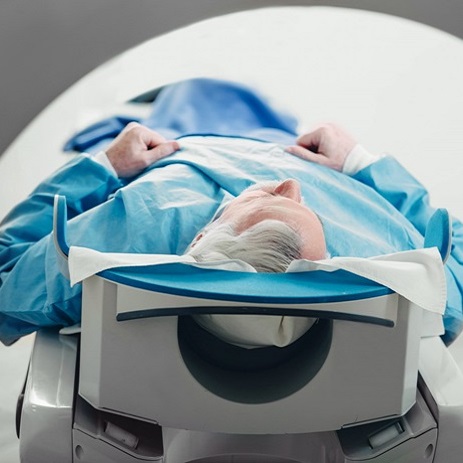New Technology Attacks Lung Cancer Sooner, When It’s Most Treatable

September 22, 2022
Kathleen Keenan Weil, 66, has good reason to be alert and proactive when it comes to her health.
Twenty years ago, she was diagnosed with stage 3a squamous cell carcinoma after undergoing a right lung thoracotomy lobectomy. This surgery involved cutting 8 inches from her armpit to her rib cage and left her in the hospital for almost a week. After a few months slowly recovering from surgery at home, Kathleen faced even more months of chemotherapy.
So last winter, when she noticed she was easily feeling out of breath, Kathleen immediately went to her pulmonologist to request a CT scan. The scan showed an 8-mm ground-glass opacity, a hazy lesion suspicious of cancer, in her left lung.
Her pulmonologist recommended waiting and monitoring her condition, but Kathleen, who lives on the Jersey Shore, decided to take matters into her own hands. On a friend’s recommendation, she met with a thoracic surgeon at Hackensack University Medical Center for a second opinion.
"Me being me, I don't wait and see. I didn’t want to worry about it for another few months after what I've already been through and what I know about it,” says Kathleen, a widow and mother to an adult son.
Hackensack doctors recommended a therapeutic wedge resection to surgically remove a wedge-shaped section of lung tissue including the lesion. Because the lesion was still so small, the procedure would act as both the biopsy and the treatment. The best option for Kathleen was to use the Ion, a new robotic-assisted technology. Thoracic surgeon Geoffrey B. Pelz, M.D., who was the first surgeon in New Jersey to use the Ion, was brought in to assist with the procedure because of his expertise.
Innovative Surgical System
The Ion endoluminal system is a minimally invasive tool that allows thoracic surgeons and pulmonologists to navigate the lungs’ vast network of airways to biopsy nodules in hard-to-reach areas.
The surgeon uses a CT scan to construct a detailed, 3D picture of the lungs using Ion's software to plan the procedure. “It's similar to GPS,” says Dr. Pelz. “I'll mark where the target lesion is in the lung, and then the computer will generate a roadmap to that area.”
A thin and easily maneuverable catheter is then inserted into the patient’s breathing tube, while real-time imaging is synced with the CT scan to guide the surgeon, who uses the Ion’s controller to navigate. “It's almost like a video game for the surgeon where you have a scroll wheel and a trackball, and you use it to drive a tiny camera all the way to the edges of the lung,” says Dr. Pelz.
In addition to taking biopsies, the Ion is used to localize lesions prior to other procedures by injecting the lung nodule with dye. In Kathleen’s case, Dr. Pelz used the Ion technology to dye mark the target lesion and then performed a therapeutic wedge resection using the da Vinci robotic surgical system.
“We saw that Kathleen’s mass was growing slightly and getting a bit more dense, but it was still very small and more of a hazy patch on the CT scan. This makes it challenging to find because it's not a hard dense ball. You could run your instrument over the lung and you would have no idea where the mass was,” says Dr. Pelz. “But with the Ion, we knew exactly where to go based on the dye.”
This time, Kathleen’s cancer—a stage 1 adenocarcinoma in her left lung—was identified and removed early. The Ion made it possible to operate at this early stage, eliminating the risk of her cancer spreading while waiting for it to grow big enough to be removed by traditional methods.
Another advantage of the Ion is that it allows surgeons to perform lung-sparing surgeries, which was especially helpful for Kathleen as she’d already lost lung tissue in her surgery for her first cancer.
A ‘Cakewalk’ Surgery
Kathleen spent a night in the hospital recovering from the procedure before returning home and was quickly back to her normal, active self. She was impressed with the easy recovery compared to her previous experience 20 years before. “This was a ‘walk-in-the-park’ surgery,” she says. “Last time, it was a long, drawn-out affair. I couldn't get out of bed. I was on prescription pain medication for three months from the pain of opening up my rib cage and all the stitches.”
Faster and easier recovery times are other benefits of using the Ion—along with a faster recovery time means patients can start any needed treatment much sooner compared to traditional open surgery. Kathleen is being monitored by oncologist Harry Harper, M.D., and has had 30 radiation treatments since surgery.
“It's an incredible technology that has dramatically sped up recovery and improved patient care,” says Dr. Pelz. “For Kathleen, it meant we could localize and resect the lesion and get her in and out of the hospital in a day, so she could get back to her life.”
Next Steps & Resources:
- Meet our source: Geoffrey B. Pelz, M.D.
- To make an appointment with Dr. Pelz or a doctor near you, call 800-822-8905 or visit our website.
- Learn more about robotic-assisted technology at Hackensack Meridian Health
The material provided through HealthU is intended to be used as general information only and should not replace the advice of your physician. Always consult your physician for individual care.

When Should You Get a Lung Cancer Screening?
Lung Cancer Screening: Learn when a low-dose CT scan is right for you. Dr. Rizk explains who should be screened and why. Schedule your appointment today.

The Facts About Lung Cancer Screening
Learn lung cancer screening facts. Early detection improves survival rates. Simple, low-risk procedure. Call 800-822-8905 to schedule.

Robotic Surgery a Success for Diverticulitis Patient
Dennis Johnson’s life was saved by robotic-assisted surgery at Raritan Bay Medical Center. This technique leads to faster healing and fewer complications.

Innovative Surgery Saves Babies Born with Deadly Airway Compression
Innovative surgery saves babies with deadly airway compression. Hackensack University Medical Center offers expert care. Learn more & schedule an appointment.

How to Shrink Your Prostate
Shrink your enlarged prostate. Learn about treatment options, including medication and surgery, from Hackensack University Medical Center urologists. Call 800-822-8905.

Doctors Find Rare Cause of Kidney Stones in Infant
When doctors found kidney stones in then-8-month-old Ali Alsaidi, they discovered that a rare cause was behind it.


